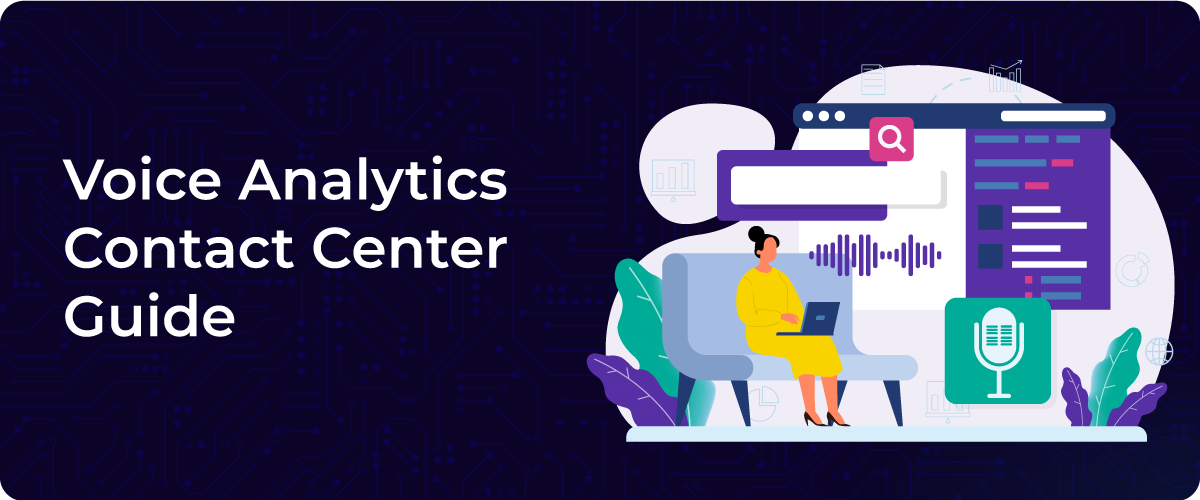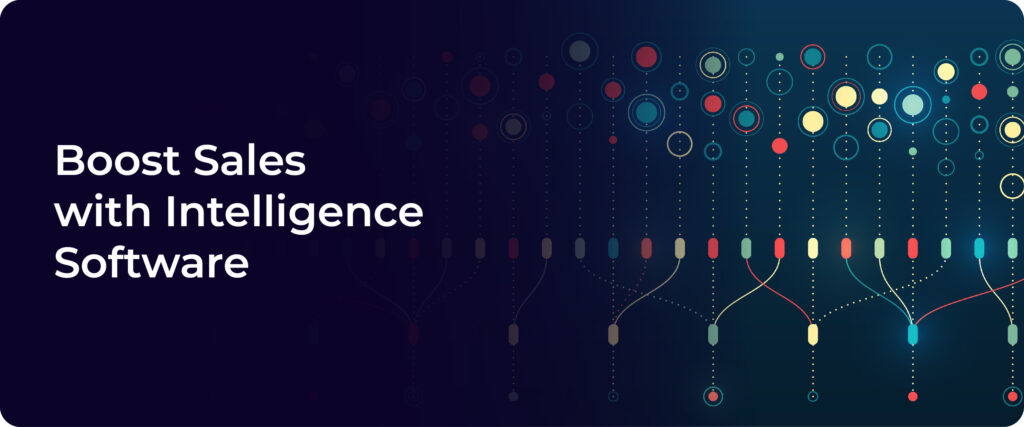
In the dynamic landscape of customer interactions, businesses are increasingly turning to advanced technologies to glean valuable insights and enhance customer experiences. One such technology making waves in contact centers is call center voice analytics. This innovative tool harnesses the power of artificial intelligence (AI) to transform spoken conversations into actionable data, unveiling a treasure trove of information that can reshape the way organizations approach customer service.
In this comprehensive guide, we delve into the realm of voice analytics call center solutions, unraveling its definition, differentiating it from speech analytics, exploring its practical applications, and highlighting its transformative voice analytics benefits. Moreover, we delve into essential tips and best practices for successful implementation, ensuring that businesses extract maximum value from this game-changing technology.
What is Call Center Voice Analytics?
Call center voice analytics software is a technology that employs AI voice analytics algorithms to analyze spoken conversations within the context of customer interactions. By capturing, transcribing, and analyzing voice data, businesses gain insights into customer sentiment, preferences, pain points, and behavior. This empowers organizations to make informed decisions, enhance voice analytics in customer engagement, and optimize operational efficiency.
Voice analytics call center tools go beyond simple call recording by deciphering nuances in tone, emotion, and language patterns, offering a holistic view of customer interactions. The ability to understand not just what customers say but how they say it makes real-time voice analytics indispensable for modern contact centers.
Voice Analytics vs Speech Analytics
Speech analytics is a speech technology that identifies keywords and phrases from conversations. It helps contact centers sort and tag calls into categories (e.g., “refund request” or “technical issue”) by detecting certain words or phrases. Whereas voice analytics goes deeper for analyzing tone, sentiment, and intent to understand how things are said and felt.
| Aspect | Speech Analytics | Voice Analytics |
| Primary Focus | Transcribes conversations and identifies keywords | Interprets meaning, tone, sentiment, and intent |
| Depth of Analysis | Surface-level (what was said) | Deeper-level (how it was said and why) |
| Technology Used | Keyword spotting and basic transcription | Advanced AI and machine learning for contextual and emotional analysis |
| Key Benefits | Helps categorize calls and track trends | Improves agent performance, personalizes service, and enhances customer experience |
| Application | Call tagging, compliance monitoring | Sentiment analysis, real-time insights, quality assurance |
| Insights Provided | What was discussed | What was meant and how customers felt |
| Use in Contact Centers | Basic reporting and call categorization | Proactive interaction management and strategic decision-making |
Practical Applications of Voice Analytics in Call Centers
Turn Conversations into Data
Voice analytics transforms customer calls into actionable insights by analyzing tone, sentiment, and language patterns at scale.
- Converts spoken conversations into structured data
- Detects recurring issues and customer pain points
- Tracks sentiment shifts and emotional tone
- Identifies patterns in customer behavior
- Supports data-driven improvements in service and products
- Enables real-time decision-making
- Aligns business strategies with actual customer needs
- Improves operational efficiency through continuous feedback
- Reduces reliance on manual feedback
- Enhances CX with AI voice analytics tools
Gain Competitive Insights from Calls
Voice analytics uncovers customer views on competitors, trends, and preferences—helping brands stay ahead in the market.
- Analyzes customer mentions of competitors
- Highlights product or service preferences
- Detects early signals of market shifts
- Informs product development and innovation
- Refines marketing messages based on real customer language
- Aids in positioning against industry rivals
- Tracks sentiment toward competing brands
- Helps tailor offers to match market expectations
- Provides data for competitive benchmarking
- Supports proactive strategic planning
Improve Quality Monitoring and Agent Training
Voice analytics identifies gaps in call quality and agent performance, guiding more targeted training and support.
- Flags non-compliant or subpar calls
- Detects signs of miscommunication or frustration
- Tracks performance trends by agent/team
- Provides objective quality metrics
- Suggests tailored coaching opportunities
- Enhances onboarding with real call examples
- Reduces customer churn by improving interactions
- Enables performance benchmarking
- Supports continuous agent development
- Ensures adherence to compliance standards
Read Also: What is Conversational Analytics?
Benefits of Voice Analytics in Call and Contact Centers
Cost-Effective Customer Insights
Voice analytics automates call reviews, saving time and cost while offering deep, data-driven understanding of customer needs.
- Replaces manual call review with AI automation
- Analyzes large volumes of conversations instantly
- Reduces reliance on human resources
- Identifies customer pain points and expectations
- Delivers actionable insights faster
- Cuts operational costs without sacrificing accuracy
- Improves decision-making based on real data
- Increases efficiency in feedback loops
- Enables scalable customer insight collection
- Drives growth with less resource strain
Easy Keyword & Topic Tracking
Voice analytics simplifies tracking of key terms and topics, helping businesses spot trends and patterns effortlessly.
- Automatically detects important keywords
- Categorizes topics across all calls
- Uncovers recurring customer issues
- Identifies market trends quickly
- Highlights emerging product feedback
- Streamlines reporting and analysis
- Aids in campaign or product targeting
- Supports proactive customer service strategies
- Offers high visibility into voice-of-customer
- Improves strategy with accurate, fast insights
Real-Time Customer Experience Improvements
Voice analytics lets businesses act on customer sentiment as it happens, improving service and reducing escalations.
- Monitors calls in real-time for tone and intent
- Alerts teams to negative sentiment immediately
- Enables proactive resolution of issues
- Prevents customer dissatisfaction from escalating
- Enhances live agent support and supervision
- Builds trust through timely interventions
- Improves responsiveness to feedback
- Boosts customer satisfaction and loyalty
- Informs on-the-fly coaching and performance tips
- Supports agile service delivery
Integrates with Existing Tools
Voice analytics easily connects with current systems like CRMs to enhance personalization and customer engagement.
- Seamlessly integrates with CRM and helpdesk tools
- Shares insights across platforms for consistency
- Gives agents real-time access to call history
- Enhances personalization with historical context
- Improves workflow efficiency
- Reduces tool-switching for agents
- Supports unified customer profiles
- Boosts campaign targeting accuracy
- Strengthens omnichannel experience
- Elevates overall service quality
Tips, Best Practices, and Implementation
1. Data Privacy and Compliance
- Tips:
Always anonymize customer data and strip personally identifiable information before analysis. Use strong encryption during data transmission and storage. Stay up-to-date with data protection regulations like GDPR and HIPAA. - Benefits:
Ensures customer trust, reduces legal risks, and protects sensitive data while using voice analytics tools. - Implementation:
Integrate anonymization tools, apply end-to-end encryption protocols, and establish compliance checklists for your voice analytics software.
2. Set Clear Objectives
- Tips:
Define specific, measurable goals for using voice analytics (e.g., improving agent performance, spotting customer trends, or enhancing experiences). - Benefits:
Keeps the project focused, enables ROI tracking, and ensures alignment with business priorities. - Implementation:
Align your analytics setup (keywords, tags, metrics) with your business objectives and regularly review progress toward those goals.
3. Collaborate with Agents
- Tips:
Involve agents in the setup process. Gather their insights on call patterns and customer behavior. - Benefits:
Boosts system accuracy and encourages agent buy-in and engagement. - Implementation:
Conduct training and brainstorming sessions, and incorporate agent feedback into analytics models and keyword detection rules.
4. Continuous Monitoring and Refinement
- Tips:
Regularly reassess the system’s accuracy and relevance. Update parameters based on evolving customer behavior and business goals. - Benefits:
Keeps insights fresh, actionable, and aligned with current needs. - Implementation:
Schedule periodic reviews, tweak algorithms and criteria, and implement AI-based learning loops to enhance precision.
5. Integrate Insights Across Departments
- Tips:
Share voice analytics insights with marketing, product, and customer support teams to maximize impact. - Benefits:
Supports better campaigns, smarter product improvements, and personalized customer experiences. - Implementation:
Build cross-functional dashboards and reports, hold regular insights-sharing meetings, and embed analytics into cross-team workflows.
Elevate Customer Experience with ConvozenAI Call Center Voice Analytics
ConvozenAI has AI technology and speech processing to analyze tone, emotion, and intent in customer calls. It provides information intended to improve agent performance, ensure compliance, and provide real-time, actionable insight. Improve Call Center Efficiency as ConvozenAI automatically monitors keywords and sentiment, allowing you to maximize customer engagement, while improving operational efficiencies for contemporary contact centers, among many other features.
Are you ready to improve your customer interaction? Start using ConvozenAI now to increase performance in your call center!
Unleash Your Contact Center’s Potential Today! 👉 Get Started with ConvoZen.AI and Elevate Customer Experience.
Schedule a Demo Now!
FAQs
1: What is Voice Analytics and how does it work in contact centers?
Voice Analytics uses AI to convert calls into text, analyzing tone, sentiment, and language to deliver insights that improve agent performance and customer experience.
2: How is Voice Analytics different from Speech Analytics?
Speech Analytics finds keywords; Voice Analytics goes deeper, analyzing emotion, tone, and context for a fuller understanding of customer sentiment and intent.
3: What are some practical applications of Voice Analytics in contact centers?
Voice Analytics helps monitor quality, personalize interactions, detect issues in real-time, and extract actionable insights from customer conversations.
4: How does Voice Analytics enhance customer insights while being cost-effective?
By automating analysis, Voice Analytics saves time and cost while revealing deep insights into customer sentiment, behavior, and preferences.
5: What benefits does Voice Analytics offer in terms of customer experiences?
Voice Analytics enables real-time monitoring, emotional analysis, and proactive responses, enhancing personalization and customer satisfaction.
6: What role does Voice Analytics play in agent performance enhancement?
It identifies communication gaps, supports targeted training, and helps agents meet quality standards more effectively.
7: Can Voice Analytics provide insights into emerging trends and competitive intelligence?
Yes, it reveals customer preferences, perceptions, and market trends, offering strategic advantages for product and service improvements.
8: How can businesses ensure data privacy and compliance while implementing Voice Analytics?
Use anonymization, encryption, access controls, and follow regulations like GDPR to protect customer data and ensure compliance.
9: What tips should businesses consider for successful Voice Analytics implementation?
Set clear goals, involve agents, monitor algorithms, integrate insights across teams, and prioritize privacy and ethics.
10: How does Voice Analytics seamlessly integrate with existing tools and platforms?
It enhances CRM and contact center systems by sharing real-time insights that support personalized service and data-driven decisions.
11: How does Voice Analytics contribute to compliance monitoring and risk management in contact centers?
It detects protocol breaches and risky language, helping mitigate legal risks and support ethical communication.
12: Can Voice Analytics enhance the training and onboarding process for new agents?
Yes, real conversations offer practical learning, helping new agents understand customer dynamics and accelerate their readiness.
13: How does Voice Analytics contribute to sentiment analysis and understanding customer emotions?
It evaluates tone, language, and context to understand emotions, enabling empathetic and emotionally intelligent customer interactions.
14: Can Voice Analytics be customized to cater to industry-specific jargon and terminology?
Absolutely. It can be trained on domain-specific language, ensuring accurate interpretation and relevant insights.
15: How can Voice Analytics assist in measuring the success of customer engagement initiatives?
It tracks sentiment, satisfaction, and strategy impact, turning engagement data into measurable, actionable insights.


